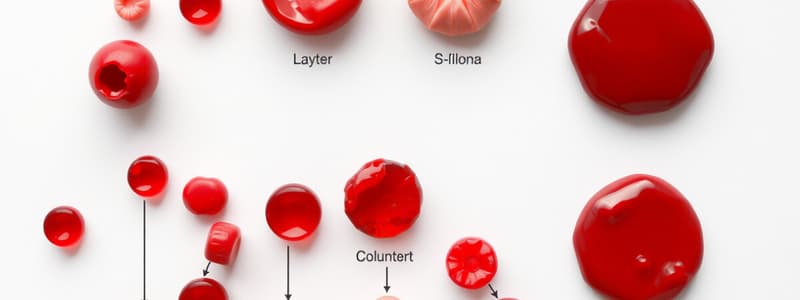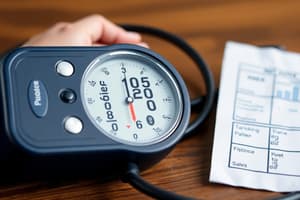Podcast
Questions and Answers
In terms of its tissue classification, blood is classified as a _________________________
In terms of its tissue classification, blood is classified as a _________________________
connective tissue
Blood has living blood cells called ______________
Blood has living blood cells called ______________
formed elements
These blood cells are suspended in a nonliving fluid matrix called
These blood cells are suspended in a nonliving fluid matrix called
plasma
The fibers of blood only become visible during
The fibers of blood only become visible during
Most of the compacted cell mass is composed of
Most of the compacted cell mass is composed of
The volume of the blood accounted for by these cells is referred to as the
The volume of the blood accounted for by these cells is referred to as the
The less dense ______ rises to the top and constitutes about 45% of the blood volume
The less dense ______ rises to the top and constitutes about 45% of the blood volume
The so-called 'buffy coat', composed of ___________ and __________, is found at the junction between the other two blood elements
The so-called 'buffy coat', composed of ___________ and __________, is found at the junction between the other two blood elements
The buffy coat accounts for less than ______ of blood volume
The buffy coat accounts for less than ______ of blood volume
Blood is scarlet red in color when it is loaded with __________, otherwise it tends to be dark red
Blood is scarlet red in color when it is loaded with __________, otherwise it tends to be dark red
Most numerous leukocyte
Most numerous leukocyte
Granular leukocytes
Granular leukocytes
Also called an erythrocyte, anucleate
Also called an erythrocyte, anucleate
Actively phagocytic leukocytes
Actively phagocytic leukocytes
Agranular leukocytes
Agranular leukocytes
Fragments to form platelets
Fragments to form platelets
Examples of formed elements
Examples of formed elements
Increases during allergy attacks
Increases during allergy attacks
Releases histamine during inflammatory reactions
Releases histamine during inflammatory reactions
After originating in bone marrow, may be formed in lymphoid tissue
After originating in bone marrow, may be formed in lymphoid tissue
Contains hemoglobin
Contains hemoglobin
Primarily water, noncellular; the fluid matrix of blood
Primarily water, noncellular; the fluid matrix of blood
Increases in number during prolonged infections
Increases in number during prolonged infections
Least numerous leukocyte
Least numerous leukocyte
Also called white blood cells
Also called white blood cells
What is the stimulus for making more RBC?
What is the stimulus for making more RBC?
White blood cells move into and out of blood vessels by the process of...
White blood cells move into and out of blood vessels by the process of...
An abnormal decrease in the number of WBCs is...
An abnormal decrease in the number of WBCs is...
A normal pH range of blood is _____
A normal pH range of blood is _____
The cardiovascular system in an average adult contains approximately _______ liters of blood
The cardiovascular system in an average adult contains approximately _______ liters of blood
Anemia resulting from a decreased RBC number causes the blood to become _______ viscous
Anemia resulting from a decreased RBC number causes the blood to become _______ viscous
Rank the following lymphocytes from most abundant to least abundant
Rank the following lymphocytes from most abundant to least abundant
Study Notes
Blood Classification and Composition
- Blood is classified as connective tissue, consisting of living cells and a nonliving matrix.
- Living blood cells are known as formed elements, suspended within a fluid matrix called plasma.
- The solid components of blood primarily contain erythrocytes, which make up the majority of the cell mass.
- Plasma constitutes about 55% of blood volume and is the less dense component that rises to the top.
Blood Components
- The hematocrit is the term for the volume percentage of red blood cells in blood.
- The "buffy coat" is a thin layer between erythrocytes and plasma, consisting of leukocytes and platelets, accounting for less than 1% of total blood volume.
- Blood is bright scarlet red when oxygenated and dark red when deoxygenated.
White Blood Cells
- Neutrophils are the most numerous type of leukocyte and are actively phagocytic.
- Granular leukocytes include neutrophils, eosinophils, and basophils, while agranular leukocytes consist of monocytes and lymphocytes.
- Eosinophils increase during allergy attacks, whereas basophils release histamine during inflammatory responses.
- Monocytes are elevated during prolonged infections.
Red Blood Cells
- Red blood cells (RBCs), or erythrocytes, lack nuclei and are crucial for transporting oxygen due to their hemoglobin content.
- The stimulus for increased red blood cell production is low oxygen levels in the blood.
- Blood viscosity decreases when there is a reduction in red blood cell count.
Blood Cell Regulation and pH
- Diapedesis is the process by which white blood cells exit blood vessels to perform immune functions.
- Leukopenia refers to an abnormal decrease in the number of white blood cells.
- Normal blood pH ranges from 7.35 to 7.45, maintaining acid-base homeostasis.
Blood Volume
- The average adult cardiovascular system contains approximately 5.5 liters of blood, vital for bodily functions.
Lymphocyte Abundance
- The order of abundance for lymphocyte types is: Neutrophil, Lymphocyte, Monocyte, Eosinophil, Basophil.
Studying That Suits You
Use AI to generate personalized quizzes and flashcards to suit your learning preferences.
Description
This quiz covers the classification and composition of blood as a connective tissue, its cellular components, and the role of different types of blood cells. You will explore topics such as erythrocytes, plasma, and the functions of leukocytes. Test your knowledge on how blood is structured and its various functions in the body.



